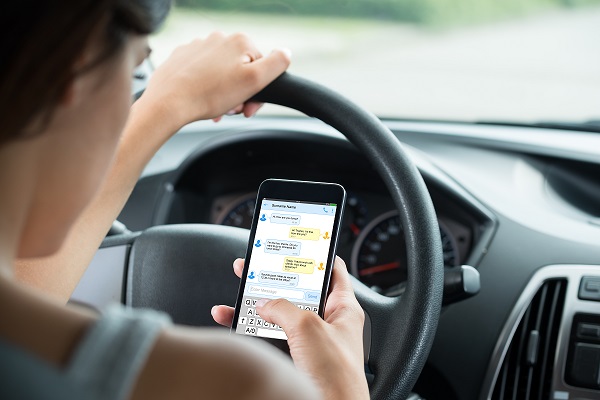Georgia Ranks 6th for Most Distracted Driving Accidents in 2023

In the fast-paced world of modern life, it's no secret that distractions can creep into every aspect of our daily routines. Unfortunately, when these distractions find their way into our time behind the wheel, they can lead to severe and sometimes fatal consequences.
More than 3,500 people died in distracted driving accidents across the United States in 2021. That's a 13% increase from the pre-pandemic era of 2019. But how bad is distracted driving on the statewide level? The United Services Automobile Association (USAA) recently broke down the rate of distracted driving by state, including Georgia.
The Law Offices of Gary Martin Hays & Associates discusses the staggering rate of distracted driving crashes on Georgia roads. If you were injured in a crash due to someone else's inattention, our car accident attorneys can fight to hold them accountable and help you get the justice you deserve.
How many distracted driving accidents happen in Georgia?
The USAA released its top 10 states with the most distracted drivers during the first half of 2023, and Georgia was ranked sixth. According to the USAA, the distraction rate here is 15.5%.
These figures come while there has been an 18% increase in miles driven from the same period in 2022. With the rise in vehicle miles driven, distracted driving across the U.S. has increased by 10%.
Distracted driving has always been a problem in Georgia. Out of 603,948 statewide car accidents in 2020, about 2% of drivers were distracted. Another 45% of drivers were suspected of distracted driving.
Common types of distracted driving
Distracted driving involves any activity that diverts a driver's attention away from the steering wheel and the road. There are several types of distracted driving that fall under these three categories:
- Visual distractions: These distractions occur when drivers take their eyes off the road. Examples include looking at a cellphone, checking a GPS device, reading billboards, or gazing at scenery.
- Manual distractions: Manual distractions happen when drivers take their hands off the wheel. Examples include eating and drinking, adjusting the radio or infotainment system, grooming or applying makeup, or using a handheld device.
- Cognitive distractions: Cognitive distractions occur when drivers take their focus off the task of driving. These can be particularly dangerous because they impair drivers' ability to react to unexpected obstacles. Examples include conversations with passengers, daydreaming, emotional distress, and thinking about non-driving-related tasks.
Among these distractions, texting and driving is the most dangerous because it combines all three categories. When a driver texts behind the wheel, they take their eyes off the road (visual), their hands off the steering wheel (manual), and their focus off the task of driving (cognitive).
Distraction when behind the wheel often leads to:
- Reduced focus: Reduced focus means drivers are less likely to notice potential hazards. These include pedestrians, other vehicles, and other obstacles.
- Delayed reaction time: Distracted drivers often have slower reaction times when they need to brake or make evasive maneuvers.
- Impaired judgment: Distracted drivers often make poor judgments about speed, following distances, and the appropriate actions to take in different traffic situations.
- Decreased awareness: Distracted drivers are less aware of what's happening around them. This lack of awareness can lead to failure to yield the right of way, missed traffic signals, or lack of awareness of changing road conditions.
Georgia's Hands-Free Law
The Hands-Free Georgia Act, enacted on July 1, 2018, is aimed at curbing distracted driving by prohibiting drivers from holding or physically touching their phones while talking on them. This law extends to texting, emailing, accessing social media, or browsing the internet while driving unless using voice-to-text functionality.
Watching videos, recording videos, or operating any handheld device for such purposes is also prohibited.
However, continuous dashcams and GPS systems are exceptions. While drivers can listen to streaming music without videos, they must not physically interact with their phones to activate or program music streaming apps while driving.
The law even applies to school bus drivers, who can only use wireless telecommunications devices for two-way radio communication with school or public safety officials while loading or unloading passengers or when the bus is in motion.
The Hands-Free Georgia Act defines wireless telecommunications devices broadly, encompassing cellphones, portable phones, text-messaging devices, personal digital assistants, stand-alone computers, GPS receivers, and similar portable wireless devices used for communication, information, or data exchange.
Drivers who violate the Hands-Free Georgia Act can face penalties such as fines and points added to their driver's licenses.
What should I do if a distracted driver hits me?
If you or a loved one was hit by a distracted driver, it's important to put your health and well-being first. Get a medical evaluation if you haven't already done so. Even if you feel perfectly fine, some injuries take time to produce symptoms.
By getting a prompt medical evaluation, you address your injury before it gets worse. Plus, your diagnosis and medical record can strengthen your potential claim.
Then, consult an experienced car accident lawyer to review your potential legal options. At The Law Offices of Gary Martin Hays & Associates, our attorneys know how to investigate accidents involving distracted drivers and seek maximum compensation for injured motorists.
Contact us online to schedule your free, no-obligation legal consultation. We'd be honored to discuss the details of your crash and advise you on how best to move forward. We proudly serve injured motorists throughout the greater Atlanta area.

 Find a location near you
Find a location near you